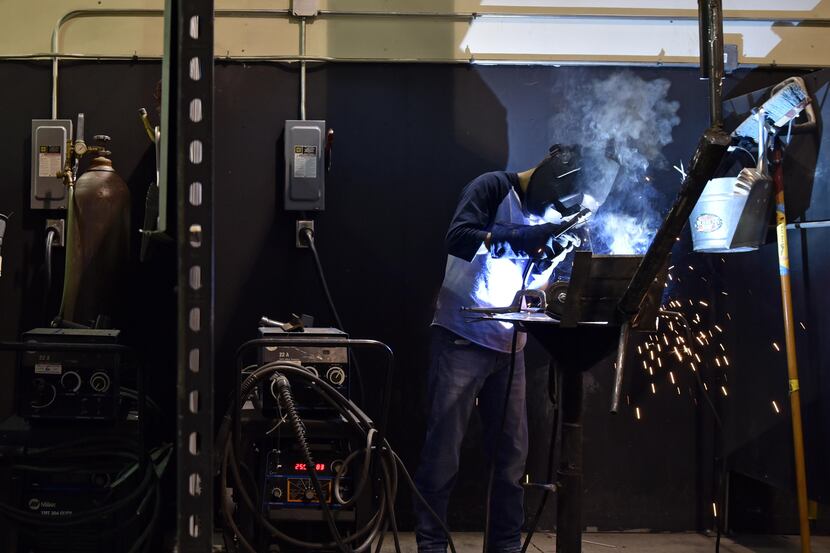The skilled labor crisis is a Texas-sized problem, and we need a new approach powered by new technologies to address it.
Today, employers statewide struggle to find qualified skilled workers. According to the Bureau of Labor Statistics, Texas reported over 988,000 job openings in June 2022. These gaps are particularly acute among middle-skill jobs in construction and manufacturing, in roles as diverse as electricians to aircraft production technicians. This challenge worsens as our workforce ages, with up to five skilled workers exiting for each new person entering via traditional channels.
Student debt forgiveness may temporarily relieve borrowers, but as a policy solution, it fails to address an underlying problem: Higher education is not sufficiently training students for valuable careers despite its rising costs. According to a 2021 College Board study, public four-year colleges have increased prices by more than 2.5 times since 1991, even after accounting for inflation. Colleges operating under Title IV regulations rely heavily on federal aid to offset mounting expenses, limiting their flexibility to innovate with shorter, non-degree programs and workforce development accelerators falling outside of the scope of traditional accreditation.
So despite continuous growth in spending, higher education institutions fail to provide fast, employer-centered solutions to ready our workforce. Who can blame them? Employers are not their core customer.
With major investments in the U.S. supply chain underway across critical industries such as advanced manufacturing, semiconductors, biotechnology and electric vehicles, the scale of this challenge mounts each day. To address this shortage of nearly 1 million workers in Texas and 10 million more across America, we must rapidly expand the supply of skilled talent.
We should attack this problem on several fronts.
First, technology makes it possible to source from previously untapped candidate pools. These groups include underemployed immigrants, veterans and recent graduates referred to by Harvard Business School’s Managing the Future of Work Project as “hidden workers.” More than 27 million of these people exist, united by a common desire to “unstick” their lives by moving from warehouse, retail or gig jobs into more stable careers unlocking upward mobility.
Second, software products can screen new candidates on the basis of their mindsets, dispositions and behavior markers, assessing talent on its potential rather than existing degrees. By measuring aptitude and reliability, employers can home in on candidates who demonstrate a high propensity for success, once they are equipped with the necessary credentials.
Third, virtual training combined with in-person mentorship offers low-cost, user-centered ways to upskill talent. These types of interventions ramp up the quality and speed of apprenticeship programs, enabling employers to differentiate across cohorts of individual adult learners and make targeted investments to accelerate credentialing efforts.
This isn’t just good for individuals; it makes good business sense for employers, too. With staffing agencies charging 40% to 50% premiums for temporary labor in an inflationary environment, a $10,000 investment to upskill a high-potential, entry-level skilled worker for a full-time, $25-per-hour opportunity can break even in as little as three to six months. Productive talent pays for itself in no time.
Finally — and perhaps most importantly — we must celebrate those who enter skilled professions. These builders are at the heart of American dynamism, as they are responsible for advancing next-generation economic capabilities for our nation. We should revere their examples.
Darren Green, a former U.S. Marine Corps Scout Sniper and special operator, is one such candidate to cheer. After an honorable discharge, Darren wrestled with a lost sense of mission in his transition to civilian life. Desiring a career working with his hands, he enrolled in a rapid upskilling boot camp to become a heating, ventilation and air conditioning technician, earning his entry-level credential and federal safety certification in eight weeks of intense training.
Today, Darren is employed by a fast-growing commercial HVAC operator in North Texas, finding a broader sense of meaning for the first time since returning from deployment. When someone’s air conditioning system fails, he sees an opportunity to diagnose and solve real problems in the service of his customer. Great dignity exists in his work and its impact on society.
We are in a critical moment across Texas and around the United States, and new approaches are needed to reskill our workforce to meet employers’ needs. Jobs of the future offer high purpose and high pay. It’s time for us to go build those opportunities for our fellow Americans.
Wyatt Smith is founder and CEO of UpSmith, a Dallas-based technology company with a mission to combat the skilled labor crisis. He wrote this column for The Dallas Morning News.
We welcome your thoughts in a letter to the editor. See the guidelines and submit your letter here.
